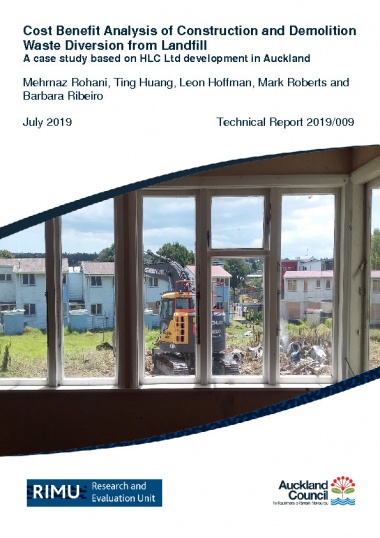Cost benefit analysis of construction and demolition waste diversion from landfill
Author:
Mehrnaz Rohani, Ting Huang, Leon Hoffman, Barbara Ribeiro, Mark RobertsSource:
Auckland Council Research and Evaluation Unit, RIMUPublication date:
2019Topics:
Housing ,EnvironmentA case study based on HLC Ltd development in Auckland.
Extracts from the Executive summary:
Sending construction and demolition (C&D) waste to landfill creates environmental problems for Auckland. Data on Auckland’s waste volumes indicate that C&D waste (e.g. rubble, concrete, timber, plasterboard, insulation materials) together account for 40 per cent of all waste sent to landfills (Auckland Council, 2018b).
Auckland Council has a vision of “Zero waste by 2040” (Auckland Council, 2018a). To achieve this, the council has set a long-term target in its Waste Management and Minimisation Plan (WMMP) of reducing total waste to landfill by 30 per cent by 2027. As Auckland’s single largest waste stream, with high tonnages going to landfill and high diversion potential, C&D waste has been identified by the council as a priority waste stream to achieve the WMMP’s target.
As C&D waste is a source of commercial waste, the council has limited influence over the construction industry’s behaviour of managing it. However, there is an opportunity to work with large-scale developers to support C&D waste diversion through wider uptake of deconstruction methods instead of demolition, and facilitating the recycle and reuse of materials.
This is a report on a high-level Cost Benefit Analysis (CBA) of two options proposed by Auckland Council’s Waste Solutions Unit for C&D waste diversion from landfill. For each proposed option, expenditure is spread across a series of activities that relate to each of the broad areas of focus identified for C&D waste diversion, namely awareness, infrastructure, brokerage, regulatory controls, training, job and business opportunities.
The CBA in this study compares a ‘current state’ option (which is based on a continuation of current expenditure and practices of C&D waste management), referred to as the status quo or counterfactual, and two alternatives, Options A and B. The study measures the changes in costs and benefits under the proposed options relative to the status quo. Based on the modelling information provided by Waste Solutions, both Options A and B will result in significant additional C&D waste diversion compared to the status quo. Option A will achieve this by focusing more on partial recovery and recycling of waste. Option B will achieve this with stronger focus on minimising waste through reduction of waste generation and reuse of waste materials.
This study focuses on C&D waste from residential developments. ...
Discussion and conclusion
Results of the economic CBA support the view that Auckland can be better off with either of the two C&D waste diversion options proposed for the HLC development. A conservative approach to measure the benefits is adopted at all times. There are benefits that are not quantifiable and hence are not included in the analysis. Option B is the preferred option, although it has a lower benefit to cost ratio compared to Option A, it delivers significantly greater net benefits to society.
Results of the distributional analysis indicate that the developers would essentially breakeven from implementing C&D waste diversion from landfill. There may be additional gains for the developers if the intangible benefits (improved reputation and credentials from diverting C&D waste) can be realised. Net returns to the developers under either option would also increase as the waste levy increases. While both options give similar propositions on the business side, however, taking results of the economic CBA into account, Option B would be more beneficial than Option A given the wider Auckland would be better off under this option.
Auckland Council technical report, TR2019/009
July 2019
